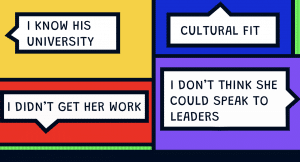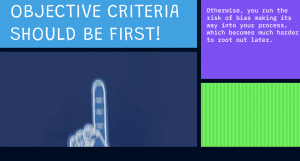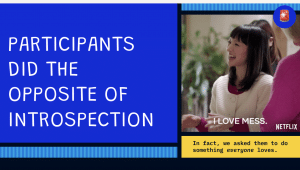Day 3-Why Changing Hearts & Minds Doesn’t Work When Promoting DE&I Efforts, but Checklists Do

Thank you for the introduction and we are pumped to be here
-
Use lot of animated GIFs and have tried to avoid unexpected contrasts
-
Will lean on those in chat to look at certain content

— We can all say 2020 was a very interesting time
-
Witnessed unprecedented number of people taking to the streets
-
It felt like people were getting on board
-

— Saw brands with sponsored conversations, DEI statements, and focus on equity focused roles
-
What a time for the DEI enthusiast

— Wanted to bring design org with parity with rest of the org with DEI
-
We did a book club, media club, and Slack channel

— These efforts didn’t work. Excitement turned to burnout and we were stressed and not moving needle on goals

— Most importantly we couldn’t scale
-
Dominique Ward defines scale as doing less while having greater impact
-
We were doing the most on our team and little impact
-

— So what were the goals?
-
1) Change makeup of the design team
-
2) Provide access to jobs and salaries to those historically excluded

— Reflected on things we did
-
Had good attendance and engagement but didn’t equal success in terms of outcomes

— So people were talking, but when we asked “How have you seen this show up at org?”
-
There was radio silence when this was asked

— This set up problem that all we talked about was too removed from day-to-day work and organizational context
-
People were at remedial Race Relations 101, while we were asking for high-level analysis

— This was bolstered by data in our org and others
-
Study by HBR talking about DEI in workplace pointed out where BIPOC have more mistakes listed with feedback
-
Less leadership mentions for BIPOC versus white women
-
Women 11x more likely to be described as abrasive
-

— So we changed our focus from hearts and minds to tangible impact on company goals

— Two ways we did this:
-
Created objective evaluation criteria
-
Evidence-based performance reviews

— Before criteria, we’ll touch upon three group norms (from Michelle Bess), commitments made to the virtual space together
— Three group norms
-
Stay present and don’t check out of conversation, as much as possible
-
Be open, as we are offering new perpsectives, and resist the urge to dismiss what you are hearing.
-
Reflect on how this might work, and approach with curiosity
-
-
Sit with discomfort, and you can see yourself reflected in stories told
-
Sit with uncomfortable feelings and where they are coming from
-

— We’ll kickoff the discussion with a story

— We were hiring an early career reseracher org
-
We had a Black female candidate who had credentials from agency, with master’s experience
-
Our white female research lead passed on her, and we could understand this

— But to our suprise, she then had a portfolio review with white man who had no degree, and said to hire him

— I would say that’s pretty racist, but

— There was a lot of word salad thrown out to minimize what happened

— So we decided to do side-by-side comparison of the two candidates and this got me thinking on objective metrics
-
We were moving the goalposts on who was applying

— So we created 12 core competencies for design org
-
Not just product designers and researchers but analysts
-
Worked to talk through skills important for each capability
— Note that we don’t expect to have person be strong in all 12, but to have most important skills for capability representing and level in org

— We used example and demonstrated behavior for a skill like writing
-
i.e. writing macro and micro-copy

— What is the best way to measure them, and how the org would measure them
-
Encouraged people to share evaluation methods on Slack

— We used a scale for actions over perceived knowledge and how individual used the competency
-
Scale ranged from being completely unfamiliar with the competency to using it in new ways

–– How knowledgable you are often dpeends on the eye of the beholder
-
Might go to great school, but an interviewer can disregard that

— You can move from “I know” which is subjective, to “I can” which can be demonstrated

— So coming up with objective criteria is first thing to do
-
Without this, run risk of all biases running into processes
-
This is hard to fix after the fact

— We laid the foundation for future work we did
-
Filling out cheat sheet for guide to take basic hiring information and what you are looking for when hiring for someone
-
Pick-up required competencies (3 and at what level)
-
Behaviors in case studies and actions to demonstrate, along with sample discussion questions
-
Finally have archetype
-
-
Highlight three non-negotiables , and archetype to help sort out closely qualified candidates
-
We included a Figjam on work and joint notes for evaluating candidate and why might be good fit
-

— Creating objective criteria helped team be more expansive and helped people notice when they were looking for reasons not to hire someone
-
If person met basic competencies, they could pass on to next tier of interview
— This helped us ask right questions, and why this particular candidate and select this one and ask if bias is showing up
-
Great feedback on this to be clear about role for team

— Found objective criteria and tying or to org cycle helped work with individuals from changing way we are all thinking, and instead change specific process
-
Applied logic to employee journey
-
Example of performance review process at organization
— So where would you focus next, in the context of the employee journey:
-
We asked ourselves: Where do we see high likelihood of bias?
-
The more individuals involved as opposed to processes, more likely bias
-
So we looked at journey where HR was not in charge of process
-

— So we focused on performance reviews, where lot of bias existed
-
Literature found global ratings is a petri dish for bias, due to
-
1) Confirmation bias with notions based on characteristics and traits, and paying attention to those
-
2) People relying on potential impact only for one group (‘white men’), while others are asked to perform and provide results
-
3) Performance reviews aslo had long-term and short-term
-
Short-term: Performance reviews played part in what bonus was and compensation package for the year
-
Long-term: Evaluation tied to career opportunities inside and outside the org
-
-

— So we introduced evidence based performance reviews through a workshop and introduce process that would remove bias from feedback discussions as much as possible
-
Focus on minimizing bias from conversation

— Introduced three principles for managers and team members
- Give 3 pieces of concrete evidence for feedback you give for individual
- If asked, is this a trend, you have lot of info about individual, and more constructive criticism
- It also minimizes halo/horn effect as white men who do one thing right have everything else cast as positive,
- While for BIPOC workers, doing one thing wrong is a black-mark against you, whatever else you do

— Not enough for people to look at own feedback and eliminate bias from conversation themselves
-
Instead we ask managers to audit feedback and take what you learn to see bias
— Performance reviews based on research and examples based on workshop and examining biased feedback

— Managers audited individual pieces of feedback, and then audited all feedback to look for tends and outliers
-
This is way to see where bias slips in
-
Manager with three individuals and noticed one stood out
-
Look at characteristics and probably can see bias at play
-

— Performance review conversations to be constuctive by following up with reviewers and making it dynamic
-
Go back, and without three pieces of evidence, ask if there are other times behavior showed up?
-
Consider other critical context you are missing
-
Pay attention to trends, and have conversations with people
-

— We introduced workshop to move from looking at personality-driven moments in time ,to make performance reviews to be constructive
-
Concrete evidence based criticism let us take performance reviews

— People thought this was incredibly successful workshop compared to others

— Asked participants to do opposite of introspection, but instead…

— We asked them to audit other people’s feedback and look at others and bringing anti-bias lens to tthem

— The results?
-
Empowered team members to call out bias. Opened up performance reviews for potential bias
-
Held managers to a system for reviews
-
“The liked how objective criteria was taken to heart, and used empirical data to back up claims, and empowered people to do this themselves”
-

— We had different idea of success
-
Checklists to objective criteria and organziational cycles
— We are not fully there for accountability
-
We still need to tie performance to incentives and disincentives
— We are eager to hear your thoughts on accountability

— We also have another request
-
Want to scale practice byeond and link all resources with session to help you find pieces of the org cycle that are relevant to you, as well as associated checklists

— To sum up:
-
Checklists moved needle as they were different from free-form discussions and centered facts in objective criteria and evidence
-
Got around table and come to mutual agreement
-
Not impacted by individual bias and can make conversations where bias wouldn’t impact end result

— In conclusion, forget hearts and minds and don’t go chasing waterfalls
-
Disrupt your org with checklists
FAQ
-
Can you share version of cheat sheet? Looks amazing.
-
Yes, can share template used, but if you have competencies and criterias, do that first. The cheat sheet is a playbook
-
Link will be as Google Drive in request for resources.
-
-
-
Is the hiring cheat sheet before interviews or after? Does panel know beforehand?
-
Yes, goes out to the entire panel, and have FigJam to take notes and gut check on non-negotiables
-
Used to help write job description itself beyond strict interview space
-
-
Story behind the matching citrus shirts in the call?
-
No story, we just decided on matching citrus shirts
-

